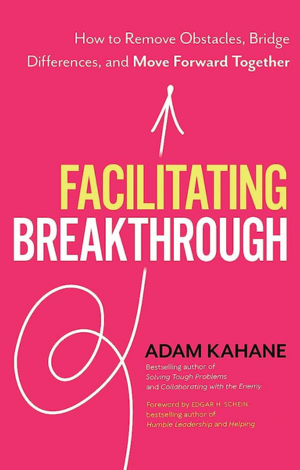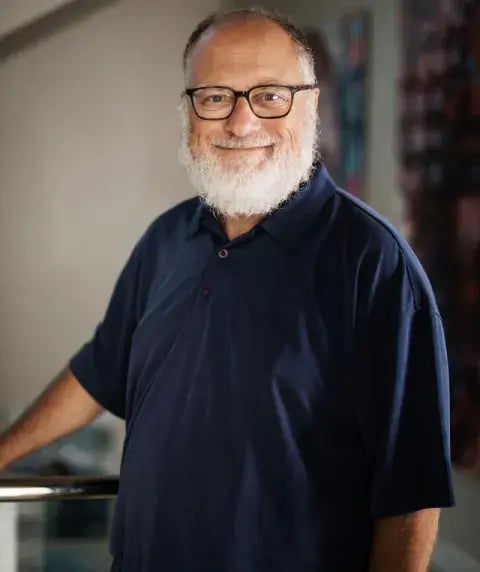

Facilitating Breakthrough
By Adam Kahane
In Adam Kahane’s latest book Facilitating Breakthrough: How to Remove Obstacles, Bridge Differences, and Move Forward Together, he introduces an innovative new approach to collaboration. In this exclusive excerpt from the book, Adam justifies the need for transformative facilitation in order to make progress on stuck issues, and maintains that anyone can facilitate change with determination and the proper guidance.
Moving forward together is becoming less straightforward.
In many contexts, people face increasing complexity and decreasing control. They need to work with more people from across more divides. This is true both within organizations and in larger social systems.
In such situations, the most straightforward and commonplace ways of advancing—some people telling others what to do, or everyone just doing what they want to do—aren’t adequate.
What is a better way?
One better way is through facilitating: helping a group collaborate across their differences to create change. The word facilitate means “to make easier,” and facilitation enables a group to work together more easily and effectively. But for diverse groups facing increasing complexity and decreasing control, the most common approaches to facilitating—bossy vertical directing from above and collegial horizontal accompanying from alongside—also aren’t adequate. These common approaches often leave the participants frustrated and yearning for breakthrough.
This book describes an uncommon approach to facilitating such breakthrough: transformative facilitation. This approach focuses on removing the obstacles that stand in the way of people contributing and connecting equitably. More fundamentally, it focuses on removing the obstacles to love, power, and justice. It enables people to bring all of themselves to making a difference. It is a liberating way to make progress.
Transformative facilitation doesn’t choose either the bossy vertical or the collegial horizontal approach: it cycles back and forth between them—not in a straight line—employing five pairs of outer moves and five inner shifts (summarized in table M.1 at the end of the book).
In doing this, it produces a third approach that delivers better results than either the vertical or horizontal one alone. Transformative facilitation is a structured and creative way to help diverse groups remove obstacles, bridge differences, and move forward together. Transformative facilitation enables breakthrough.
This book is for anyone who wants to facilitate breakthrough, be it as a leader, manager, consultant, coach, chairperson, organizer, mediator, stakeholder, or friend. A facilitator isn’t only an earnest, energetic professional in a windowless conference room or in a window in a video conference. It isn’t only someone who runs training or strategic planning exercises. It isn’t only a referee or timekeeper. It is anyone who helps people work together to transform their situation: in person or online, as a professional or amateur, in the role of team leader or team member, in an organization or community, with a small alliance or large movement, during one meeting or over an extended process. A facilitator is anyone who supports groups to collaborate to create change.
This book offers a broad and bold vision of the contribution that facilitation can make to helping people collaborate to make progress.
My understanding of transformative facilitation is based on my firsthand experience. I have worked as a professional facilitator, all around the world, for more than thirty years. I am a cofounder of Reos Partners, an international social enterprise that helps people in business, government, and civil society collaborate to address their most important and intractable issues. I have facilitated hundreds of processes with everyday teams of colleagues working to transform their organization’s strategy or operations, and with groups of people from across organizations—including people who don’t agree with or like or trust each other—working to transform their whole sector or society. So I have had lots of opportunities for trial and error and lots of opportunities for learning.
This book reports what I have learned from these experiences. Kurt Lewin, a pioneering researcher of group processes, said, “There is nothing as practical as a good theory.” This book offers a new general theory and practice of facilitation.
To read further, order your copy of Facilitating Breakthrough today.
About the Author
Adam is a leading organizer, designer and facilitator of processes through which business, government, and civil society leaders can work together to address such challenges. He has worked in more than fifty countries, in every part of the world, with executives and politicians, generals and guerrillas, civil servants and trade unionists, community activists and United Nations officials, clergy and artists.
He is a Member of the Order of Canada. In 2022 he was named a Schwab Foundation Social Innovation Thought Leader of the Year at the World Economic Forum in Davos.
